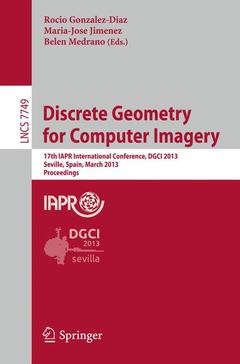Description
Discrete Geometry for Computer Imagery, 2013
17th IAPR International Conference, DGCI 2013, Seville, Spain, March 20-22, 2013, Proceedings
Image Processing, Computer Vision, Pattern Recognition, and Graphics Series
Coordinators: Gonzalez Diaz Rocio, Jimenez Maria Jose, Medrano Belen Garfia
Language: English
Subjects for Discrete Geometry for Computer Imagery:
408 p. · 15.5x23.5 cm · Paperback
Description
/li>Contents
/li>Comment
/li>
Stable length estimates of tube-like shapes.- The Complexity of Discrete Objects.- Optimal covering of a straight line applied to discrete convexity.- On dimension partitions in discrete metric spaces.- Walking in the Farey fan to Compute the Characteristics of a Discrete Straight Line Subsegment.- Persistent patterns in integer discrete circles.- Comparison of Point Clouds Acquired by 3d Scanner.- Generalized Simple Surface Points.- A parallel thinning algorithm for grayscale images.- New structures based on completions.- Asymptotic Analysis and Random Sampling of Digitally Convex Polyominoes.- Extremal connectedness of thin arithmetical discrete planes.- From the zones of influence of skeleton branch points to meaningful object parts.- Sufficient conditions for topological invariance of 2D images under rigid transformations.- The persistence space in multidimensional persistent homology.- Skeleton extraction of vertex sets lying on arbitrary triangulated 3D meshes.- Arc recognition on irregular isothetic grids and its application to reconstruction of noisy digital contour.- Reconstruction of quantitative properties from X-rays.- How to decompose a binary matrix into three convex polyominoes.- A method for feature detection in binary tomography.
Fast conference proceedings
State-of-the-art report
Up to date results




